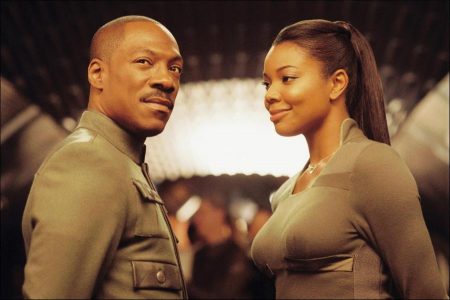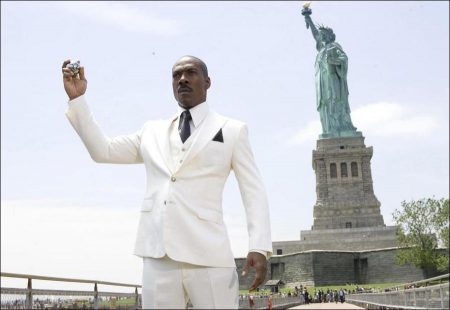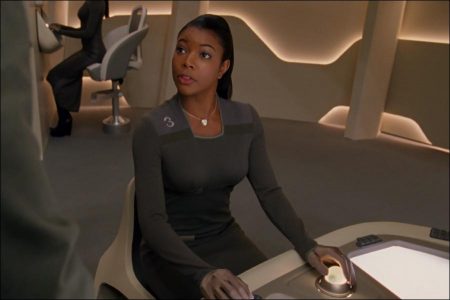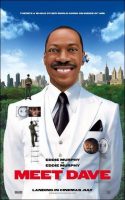Tagline: There is a whole other world going on inside him.
Meet Dave movie storyline. Dave Ming Chang, newly arrived in New York City, may be the ultimate fish out of water. There’s something about him that’s not quite right — for starters, he seems remarkably out of place and uncomfortable in his own body. And for good reason: “Dave” is not a man at all, but a ship made in the image of its miniature-sized captain. It’s little Eddie in the BIG family comedy Meet Dave.
So let’s Meet Dave. He’s forty-something, pleasant looking and nattily dressed, even if his attire — an all-white suit, black tie and a neat black handkerchief tucked in his pocket — harkens back to the disco-centric ’70s. But beyond his odd apparel, there’s something not quite right about Dave. He’s definitely not from the neighborhood… not even close. Even the way he walks is….odd; as he makes his way through the streets of New York, one of his legs shoots out way too far with each step, like he’s not comfortable in his own body.
And for good reason: inside “Dave” is a crew of well-trained miniature people — a world within a world — that feverishly attempts to direct Dave’s every action and conversation. In each section of Dave’s “body,” a skilled crewperson (average height: one and three-quarters inches), sporting an insignia depicting a specific part of Dave’s anatomy, mans a high tech console controlling Dave’s movements.
But Dave’s crew, under the direction of the Captain from whom Dave takes his appearance — is experiencing a steep learning curve. When Dave attempts his first-ever sip of water, a tremendous wave of water rushes down, drenching everyone inside. When Dave tries on some clothing, a shirt becomes a cotton beast bent on smothering him. When he goes in for a simple medical exam, the metallic Dave must battle formidable magnetic forces from an MRI. And a banquet of processed meat tubes he learns are called “hot dogs,” leads to an explosive situation inside a men’s room.
As Dave — that is, those inside Dave — slowly navigates his way through these physical challenges, they begin to experience something with even more profound effects. A glimmer of emotion sweeps over the crew, which hails from a place that discourages emotion and individuality. Dave is changing — from the inside-out, and from the outside-in.
For over two decades, Eddie Murphy has reigned as one of the cinema’s most popular comic actors — unsurpassed in his ability to take on multiple roles in a single project. In Meet Dave, Murphy’s prodigious physical and comedic talents are on display like never before, as he takes on two roles — as a man-sized ship operated by 100 mini-crewpeople, and the captain who runs the ship, which had been built in the captain’s likeness. “It’s Eddie doing what Eddie does best,” says director Brian Robbins.
But long before Murphy became “Big Dave” and “Little Dave,” screenwriters Rob Greenberg & Bill Corbett came up with the idea of a world of little people within the bigger world of a ship that takes human form. The two had met in college at the Yale School of Drama before going their separate ways, each enjoying success as writers — Corbett on the cult series “Mystery Science Theater 3000” and Greenberg on the hit sitcoms “Frasier” and “How I Met Your Mother.” For years they discussed working together, and then they met “Dave.”
Coming up with the wild notion of this world within a world was only the beginning. Greenberg and Corbett spent a lot of time fleshing out the premise, and making it as real as possible within its comedic and far-out context. “You can have a great, silly idea, but turning that into a good story that’s funny and real is the challenge,” says Corbett. “We wanted to create strong characters and personalities, each of whom is on a journey towards at least a little bit of humanization.”
“Nobody’s explored this idea — at least to this extent,” adds Greenberg. “We wanted to give this big crazy premise some semblance of reality — to create believable relationships and emotion, without sacrificing the big comedy beats.”
Greenberg & Corbett’s family comedy story caught the attention of producer David T. Friendly, whose many credits include Twentieth Century Fox’s blockbuster comedy “Dr. Dolittle” starring Eddie Murphy. “After reading the first act, I knew I wanted to make this movie,” says Friendly. “The screenplay evoked fish-out-of water stories with romantic underpinnings. And it kept surprising me.”
The script had also come to the attention of producers Jon Berg and Todd Komarnicki, then partners in the production company Guy Walks Into A Bar. Like Friendly, they were intrigued by the story’s outrageous fish-out-of-water premise and its merging of physical comedy and emotion. “Todd [Komarnicki] read the script on a red-eye back to New York,” recalls Berg, “and two hours into the flight, he was frantically writing messages that he sent as soon as he landed: ‘We have to buy this, we have to do this movie.'”
Adds Komarnicki: “I know everyone says these kinds of things when touting their projects, but reading the script was a singular experience. I knew that we had to be involved and do whatever necessary to get it made.”
Concurrently, director Brian Robbins was wrapping up the comedy “Norbit,” starring Murphy. Robbins, immersed in putting the finishing touches on what would become one of 2007’s big hits, had not read the Meet Dave script. But Murphy had, and the actor was spurred to move quickly. “Eddie came up to me and asked, ‘What are you doing after this?’ And I said, ‘I don’t know, you want to get some dinner?’ Eddie said, ‘No, not tonight — for your next movie?!’ And he handed me the Meet Dave script.”
Echoing the mandate of screenwriters Greenberg & Corbett, Robbins says, “The first thing we wanted to do was to make a funny movie. Second to that, we wanted to give the movie a sweetness and emotion. The bonds between the characters give the movie its heart, which is surrounded by the comedy.”
The project’s complex logistics were daunting. “Meet Dave was a complicated movie to bring to life,” says Robbins. “There’s an entire world inside Dave/Eddie’s head, where these mini-people exist. Then you have Dave out and about in the ‘real’ world. Then on top of that, you have Eddie playing a ship on the outside and the ship’s captain on the inside.
“I was nervous at first, wondering how I was going to make all these elements mesh,” Robbins continues. “What was Dave going to be like because he’s not human and he’s not a robot — he’s a ship!”
While Robbins was wrestling with these challenges, Murphy was slipping effortlessly into the shoes of Dave and the Captain. “It took Eddie maybe 45 minutes on the first day of shooting to make the characters his own,” recalls the director. “He made the roles different from anything he’s done before.”
Producer Todd Komarnicki marveled at Murphy’s prodigious comedy talents, which Komarnicki likens to those of some of cinema’s most renowned comedy titans. “In Meet Dave, Eddie is doing classical, old school physical comedy in the vein of Buster Keaton and Charlie Chaplin. As he plays this ship [aka “Dave”] moving through New York City, trying to hide the fact that he’s not one of us, there’s an innocence and purity to his performance that is all in the soulfulness of his eyes.”
Murphy projects the stiffness of the inanimate ship, using the athleticism that has marked so many of his memorable performances. “He has a dancer’s grace and a boxer’s focus,” says Friendly. Adds Komarnicki: “Eddie’s technical precision is put on full display, as he brings to life Dave’s lack of control as the character learns how to walk, throw a baseball, and how to dance. These are all things we take for granted, but Eddie as Dave makes them seem new and wondrous.”
Eddie’s castmates were also impressed with his embodiment of the two characters. Elizabeth Banks, who portrays Gina Morrison, a fiery and beautiful artist and single mother who literally runs into Dave early in the story, says, “We actors like to use the expression of ‘being in control of our instrument,’ our ‘instrument’ being our bodies. But I have never worked with someone who is more in control of his body than Eddie. I mean everything he does is so carefully planned and executed — every gesture, every movement of his hands and mouth — he’s totally in control of everything.”
Friendly notes that Banks, Gabrielle Union, Scott Caan, Ed Helms, Kevin Hart and the rest of the cast, brought out the best in Murphy — as he did with them. “Eddie is better with funny people around him, and they are funnier because of Eddie,” he says.
Banks, whose Gina makes a key emotional connection with Murphy’s Dave, was one of the last to be cast. But, say the filmmakers, she was worth the wait. “Elizabeth is a rare comedienne,” states Komarnicki. “She has that Lucille Ball quality, where she can do antic comedy but with a quick wit and impressive improvisational skills.”
Banks, who describes Gina as a “downtown, artsy type who loves to dance” — enjoyed playing the bond between Gina and Dave, especially during a scene in which the two are conversing about one of Gina’s paintings. “Dave is befuddled by a strangeness he feels when looking at the painting, when Gina talks about how it came from her heart. I loved how Eddie conveyed the character’s first stirrings of emotion,” she says. “It’s a scene of purity, simplicity and innocence — and laughs.”
Gina’s 11-year-old son, Josh Morrison, is the first person to Meet Dave. Josh, who is not very popular at school, makes a fast friend with Dave, introducing the strange newcomer to some local delights — like a street fair, the aforementioned “meat tubes” and the chance to teach the ultimate unsolved physics mystery — Einstein’s Unified Field Theory — to a class of fifth graders. “Josh believes in Dave from the beginning,” says young Austyn Lind Myers, who makes his film debut.
As Dave makes his way through the Big Apple, with the support of Josh and Gina, the miniature crew inside Dave is undergoing some big changes. The ship’s second in command — the aptly named #2 — is making moves to wrest the top slot from the captain. Producer Jon Berg notes that Ed Helms, who takes on the role, gets to do a movie “first”: “He pilots Eddie Murphy,” jokes Berg. “And Ed gets to play egomania run wild like no one has done before.”
Helms had a lot of fun playing the micro-sized but macro-ambitious #2. “His name signifies his rank on the ship, which is number two, which is not number one,” the actor deadpans. “Which means he’s second in command of the entire crew, except for one other person.”
And that would be the captain, whose journey guiding Dave through New York City, brings out strange sensations known as emotions in him and in many of those he commands. But #2 is immune to all this. “#2 thinks the captain is weak and susceptible to human frailties,” says Helms. “He must take action.”
Much more sympathetic to the captain is #3, the ship’s cultural officer, played by Gabrielle Union. #3’s long-suppressed feelings for her commander are brought to the fore after she, through the ship that houses her, makes contact with Gina, Josh and a slew of strange human behaviors — including, but not limited to, says Union, “happiness, sadness, jealousy, alternative life styles, and the consumption of a strange substance known as pizza.”
About her more official shipboard duties, Union notes with a laugh that #3’s key tasks include “figuring out what Doritos are and explaining Barack Obama to the rest of the crew.” And her chief tools in researching the outside world’s cultural and historical references? “Google, Yahoo…and Perez Hilton.”
Another key crewman inside Dave is #17, who handles key, well, “internal” matters. Played by Kevin Hart, #17 figures prominently in a third act scene, in which he leaps out of Dave’s ear, splashing down into a mug of coffee belonging to police officer Dooley (played by Scott Caan), who has been investigating the strange events surrounding Dave’s journey through New York. Luckily for #17, Dooley’s coffee is not too hot and is enriched with cream and sugar. Separated from his captain and crew mates, #17 makes his way through the Big Apple…in Dooley’s shirt pocket.
Much of the film’s humor and emotion comes as Dave and company encounter the city’s unique features and energy. The city is a key element of the story, so as producer David T. Friendly points out, critical scenes had to be shot on location in the Big Apple. “One of the heroes of the movie is the City of New York with all its chaos and color and craziness,” he says. And it’s only fitting that some of those scenes are set on Liberty Island — the welcoming beacon for so many newcomers to the U.S. Like Dave.
Designing Dave
Meet Dave production designer Clay A. Griffith faced a unique challenge: design a ship’s interior that had to structurally resemble the inner workings of the human body. Griffith has been inspired by such buildings as Eero Saarinen’s futuristic-looking TWA Flight Center at John F. Kennedy International Airport in New York. “It looks very skull-like and has no right angles in it,” Griffith explains. “It is compound curves that meld into other ones. I thought that was a good place to start because the human body doesn’t have a lot of right angles.”
Griffith also studied the work of Spanish architect Santiago Calatrava, who designed the Milwaukee Art Museum. “It looks like a living thing,” he says. “It’s very organic. We created the spinal column as an elevator shaft to go from different levels of the spaceship. You get off at any floor and are at a certain rib cage.”
The ship’s bridge, which is inside Dave’s head, was built on a Los Angeles soundstage. The bridge set measured 30-feet high, 30-feet wide, and 30-feet long. Griffith patterned the ship’s corridors after human-like vascular tubing, using vein and artery-hued blues and reds. Oscar-winning visual effects supervisor Mark Stetson (“Lord of the Rings: The Fellowship of the Ring”) helped create some of the film’s big set pieces, one of which sees the micro-sized Captain and #3 (remember, they’re about one and three-quarters inches tall) on the loose in the streets of New York. They must navigate the strange, foreboding — and to them, jumbo-sized — world known as Times Square. (When a dog relieves itself against a fire hydrant, the Captain and #3 must flee from the tsunami-like effects.)
For these visual effects-intensive scenes, Eddie Murphy, again, rose to the occasion. His director, Brian Robbins, wasn’t surprised. “Well Eddie is amazing,” marvels Robbins. “I mean, he can act to anything — even a C-stand and tennis ball [which, on-set, stand in for visual effects to be added later]. He doesn’t need much to play off of. You just say, ‘Action,’ and he’s there.”
Meet Dave (2008)
Directed by: Brian Robbins
Starring: Eddie Murphy, Gabrielle Union, Ed Helms, Elizabeth Banks, Judah Friedlander, Pat Kilbane, Marc Blucas, Kevin Hart, Mike O’Malley, Austyn Myers, Jim Turner, Shawn Christian
Screenplay by: Bill Corbett, Rob Greenberg
Production Design by: Clay A. Griffith
Cinematography by: J. Clark Mathis
Film Editing by: Ned Bastille
Costume Design by: Ruth E. Carter
Set Decoration by: Robert Greenfield
Art Direction by: Beat Frutiger
Music by: John Debney
MPAA Rating: PG for bawdy and suggestive humor, action and some language.
Distributed by: 20th Century Fox
Release Date: July 11, 2008
Views: 104






